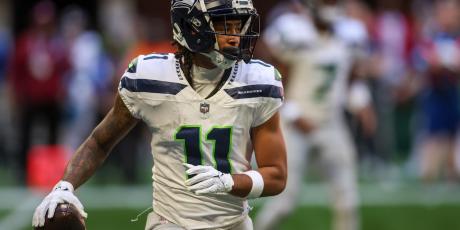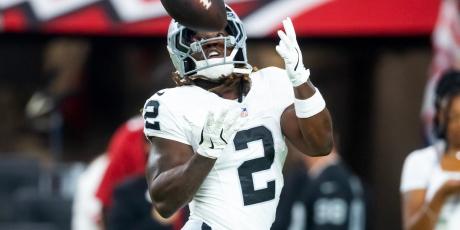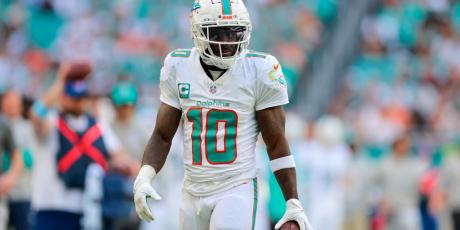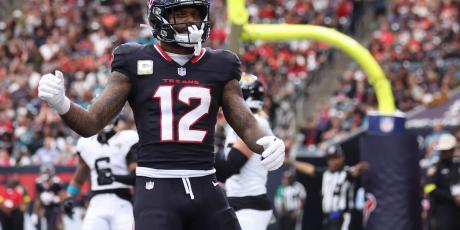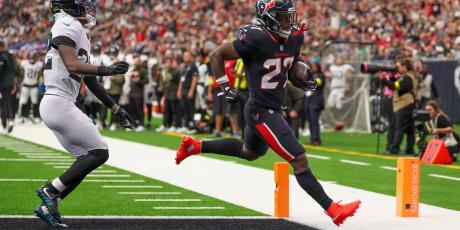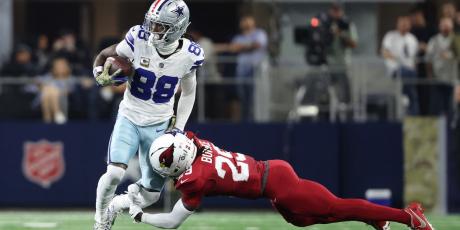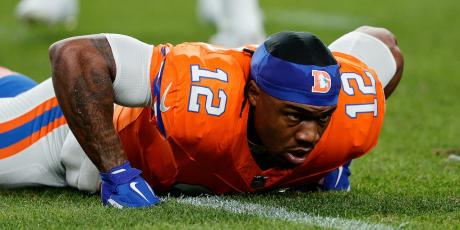Will Rachaad White's Rushing Inefficiency Hurt His Workload?

“It was the best of times, it was the worst of times” – Charles Dickens, writing about Rachaad White. There isn’t a running back with higher highs and lower lows on his profile than White. He had the third-highest EPA per target last season among RBs with at least 20 targets. But he also had the 12th-lowest EPA per rushing attempt among RBs with at least 100 carries. So, what the heck do we do with White?
Click here for more 2024 Player Profiles!
Rachaad White’s Sophomore Season
Let’s start with the positives. What I found when looking at The Most Predictable Running Back Stats was receiving statistics are crucial for future RB fantasy points. And that’s fantastic news for White. Receiving yards per game was particularly predictive, with RBs averaging more than 20 receiving yards per game more likely to have massive fantasy seasons the following year. White finished 2023 with over 32 receiving yards per game, which was fourth behind only Alvin Kamara, Christian McCaffrey, and Breece Hall.
And it wasn’t just the volume that was impressive. White flashed both talent and efficiency on his routes. White had the sixth-highest ESPN Analytics open score among RBs with at least 20 targets, along with elite marks in their catch and yards after the catch (YAC) metrics. Additionally, he finished 16th in yards per route run (YPRR) among RBs in 2023. And none of this is especially surprising, given that White had a 96th percentile YPRR in college. Any way you slice it, White is an elite receiving back in the NFL.
Now for the negatives. When looking at the most predictable RB stats, I found that RBs with over a 12% explosive run rate had better outcomes in the following season. An explosive run is just one that gained more than 10 yards. Only 7.7% of White’s carries in 2023 gained more than 10 yards. It’s a similar story for yards after contact per attempt, with White’s 2.53 yards failing to meet the 2.75-yard benchmark. And we ideally want our RBs to have an avoided tackle rate over 20% but definitely not below 14%. White barely squeaked by the red flag benchmark with 14.3% avoided tackles per attempt in 2023.
White also looked bad in the advanced stats. He finished 2023 sixth-worst in rushing yards over expected (RYOE) per attempt and in the bottom-20 in success rate. His poor success rate is less concerning because it is not predictive of future fantasy success. I found something similar when looking at best ball playoff advance rates. There was no connection between taking RBs with a high prior-year success rate and advancing more teams to the playoffs of Underdog’s Best Ball Mania IV (BBMIV).
However, that’s not the case for RYOE. Each data point in the two graphs below is a drafter that entered BBMIV 150 times. The x-axis is the RYOE per attempt of their average drafted RB, while the y-axis is the percentage of teams that drafter advanced to the playoffs. As the RYOE of a drafter’s average RB increases, so does their advance rate. But this connection really only holds for teams that tended to take RBs later in drafts. For teams that tended to draft RBs in the early rounds, the connection went away. So, that’s good news for White given that he goes in the early-sixth round in Underdog drafts. However, there is one other concerning trend with White’s RYOE.
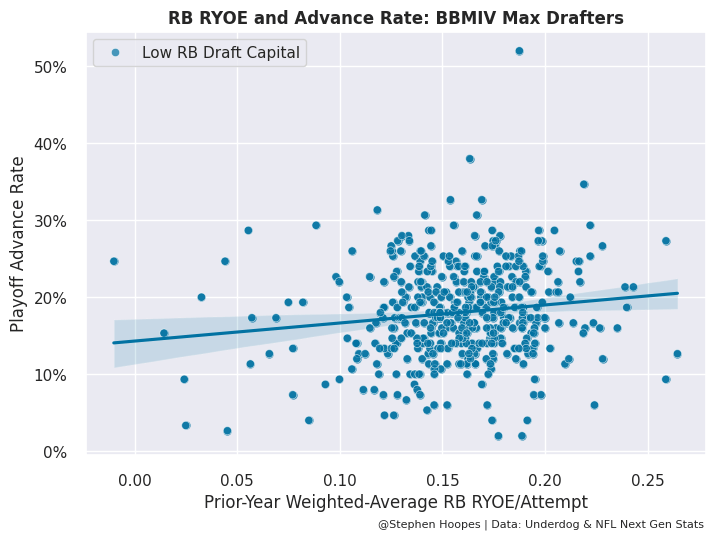
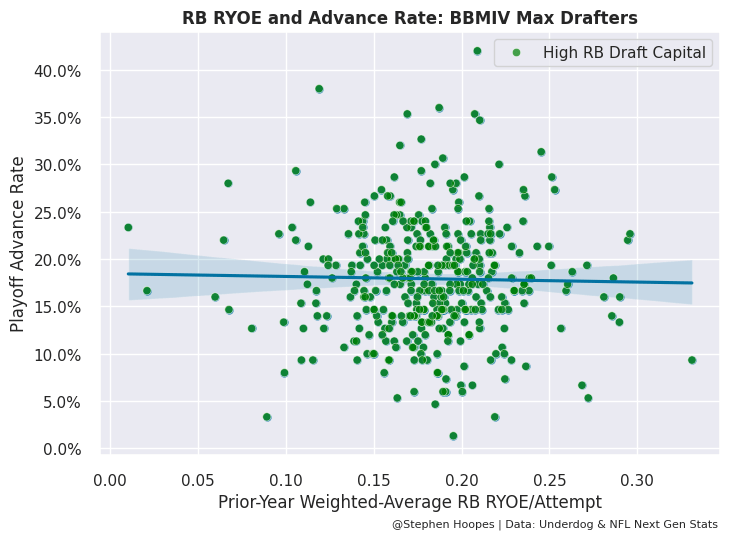
White finished dead last in 2023 with -110 RYOE when we look at the total number rather than on a per-attempt basis. RBs that hit that RYOE number or worse have averaged a 23.7% drop in rushing attempts the following season. That compares to a 2.3% increase in rushing attempts for all other RBs. And it’s not due to injury, as their games played only dropped by 4.8%. To hit -110 RYOE, an RB had to have a massive number of attempts and be inefficient on that huge volume. The table below has the list of players that have met these criteria since 2018. It’s obviously a small sample, but the list of names is concerning.
| Player | Year 1 | Year 2 | Rushing Attempts Year 1 | Rushing Attempts Year 2 | % Decline |
|---|---|---|---|---|---|
| Jordan Howard | 2018 | 2019 | 250 | 119 | -52.4% |
| LeSean McCoy | 2018 | 2019 | 161 | 101 | -37.3% |
| Todd Gurley | 2019 | 2020 | 223 | 195 | -12.6% |
| Clyde Edwards-Helaire | 2020 | 2021 | 181 | 119 | -34.3% |
| Alvin Kamara | 2021 | 2022 | 240 | 223 | -7.1% |
| Najee Harris | 2022 | 2023 | 272 | 255 | -6.3% |
The year after Jordan Howard hit -113 RYOE was the last season he got over 100 rushing attempts. That’s the same thing for LeSean McCoy. It’s also the same thing for Todd Gurley. This was also the only season where Clyde Edwards-Helaire was the bellcow in the Chiefs backfield. Again, it’s a small sample but it’s concerning for White’s future workload. But is there anyone that could reasonably take some of the volume away from him?
The Addition of Bucky Irving
The only real competition that the Buccaneers brought in was through the draft. They selected Bucky Irving in the fourth round with the 125th overall pick. And my RB prospect model really likes Irving given the importance of receiving work for RBs. He arguably had the best receiving profile in the class with elite reception and YPRR marks. He also had very strong tackle avoidance, elusiveness, and yards after contact in his final season at Oregon. One of the biggest knocks on his profile was his relatively low rush attempts per game.
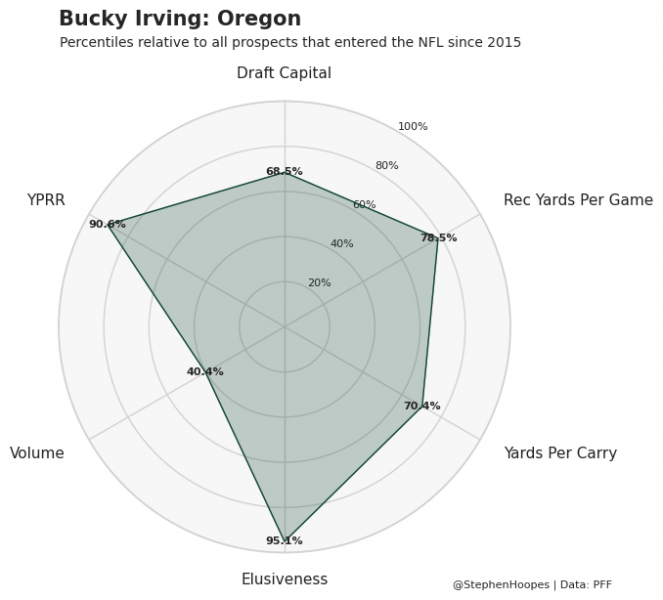
Additionally, Irving’s combine did not help his ultimate draft selection. Weighing in at only 192 pounds, Irving’s size is absolutely a concern at the next level. And with that small size, we were hoping for a blazing fast 40-time. Unfortunately, that’s not what we got. His 4.55-second 40-yard dash puts his weight-adjusted speed score in a concerningly low bucket.
So, the fit for Irving on the Buccaneers doesn’t make a ton of sense to me. He’s honestly a lot like White but smaller. The role that his college profile suggests he’d succeed in would be a third-down receiving back. But the receiving work is exactly the area where White thrives. I was hoping the Buccaneers would select or acquire a player like Khalil Herbert. Someone who profiles as a super-efficient early-down running back, allowing White to continue to dominate the receiving work.
Does He Keep the Volume?
That’s really the question you need to answer at White’s ADP. He was RB14 in fantasy points per game last year and he’s currently the 15th RB drafted on Underdog. So, White is essentially the same cost as last year but with a small sample of previous backs pointing to a potential drop in rushing volume this year. Yet, there isn’t an obvious candidate to take that rushing volume from White, with Irving profiling as a similar receiving-focused back. Overall, I’d be more comfortable taking White around RB19. I don’t want to fade White given his elite receiving profile and how predictive that is for future fantasy points. However, I am worried that his outlier-level rushing inefficiency will hurt his workload.
Bottom Line
• Rachaad White is one of the league’s best receiving RBs, finishing 2023 fourth in receiving yards per game, sixth in ESPN’s open score, and 16th in YPRR.
• Yet, he was one of the least efficient rushers last season, generating a low 7.7% explosive run rate, 2.53 yards after contact per attempt, and 14.3% avoided tackles per attempt.
• White was also dead-last in 2023 with -110 RYOE. RBs that hit that RYOE number or worse have averaged a 23.7% drop in rushing attempts the following season.
• However, there isn’t an obvious candidate to eat into his rushing workload, with Irving profiling as a similarly elite receiving back with a relatively small number of rushing attempts per game during his collegiate career.
• All in, I’m more willing to take White when he falls a few spots past ADP. Fading White’s elite receiving profile is terrifying, but so is the list of names that have been as inefficient as White on the ground.


